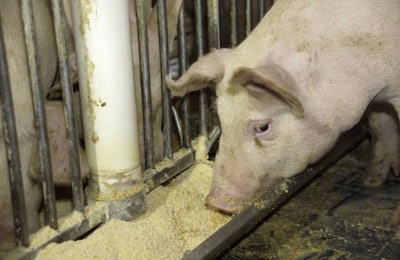
Total feed production in Germany for the grain marketing year July 2015 to June 2015 reached 24.14 million metric tons (mmt), according to the country’s association for animal nutrition, Deutsche Verband Tiernahrung e.V. (DVT). This narrowly missed beating the previous year’s record of 24.26 mmt.
Given the difficult market conditions for their customers, the livestock producers, the feed sector expressed satisfaction at the result. The CEO of DVT, Dr. Hermann-Josef Baaken, commented that limited opportunities for Germany’s animal products were holding back livestock production, and that had knock-on effects for the country’s feed producers.
Overall feed output was not much changed from the year before, but the livestock species were differently affected. Production of pig feed was almost unchanged and remained the most important sector by volume. In second place comes cattle feed, which is strongly influenced by the dairy sector, where demand fell, especially in the second half of the reporting period. Layer feed volumes increased again, while broiler feed output stagnated for a second year and just failed to meet the level produced in the previous 12 months.
Fears of a tight supply situation before the new harvest eased in recent weeks, according to the report. Grains accounted for 49 percent of the feed produced in the last year, and this looks likely to continue. There are also adequate supplies of proteins generally and particularly of soybean meal. As a result, DVT forecasts that feed prices will remain stable in the coming months. However, looking further ahead, the organization foresees that the challenges facing the livestock sectors in Germany and the rest of Europe may have knock-on effects for feed producers as output may fall.
In his introduction to the annual report, the DVT’s new president, Jan Lahde, expressed his concerns about the challenges of new feed safety legislation, which differs between regions of the country. He alleges this added bureaucracy has cost farmers millions without bringing any significant improvements in feed safety. He also expressed concerns about the no-fault liability for feed producers and called for greater harmonization of the regulations in the European Union. On animal welfare, Lahde pledged the support of the organization to help farmers to fend off criticism and improve animal well-being but he stressed the need for fair returns. There can be no progress on animal welfare if the business does not run economically, he added.
The report includes figures for the calendar year 2014 from Germany’s federal agency for agriculture and food (Bundesanstalt für Landwirtschaft und Ernährung, BLE). This puts total feed production at 24.02 mmt, 2.3 percent higher than the previous year. The largest component was pig feed, which was up 1 percent at 9.694 mmt, followed by cattle feed at 7.157 mmt, a rise of 3.6 percent. Calf feed production was up by 16.4 percent at almost 329,000 metric tons (mt). While layer feed output was 7.3 percent higher than the year before at 2.202 mmt, that for broilers was down slightly at 4.027 mmt. Total feed production last year also included almost 239,000 mt of horse feed and more than 327,000 mt for other animals.
Read the full annual report from the DVT for 2014-15 (in German)
















